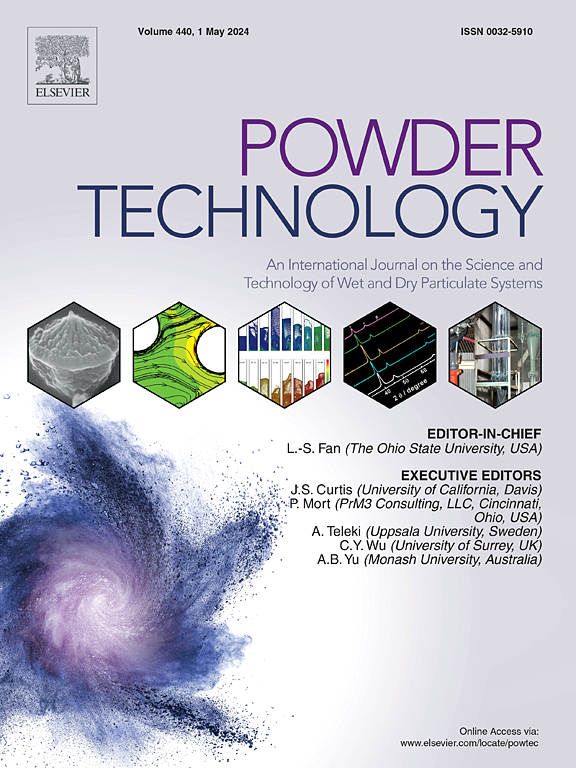Three-dimensional numerical simulation of coal and papermaking trash co-combustion in a circulating fluidized bed
IF 4.5
2区 工程技术
Q2 ENGINEERING, CHEMICAL
引用次数: 0
Abstract
Circulating fluidized bed (CFB) combustion is a important method of waste treatment with the benefits of harmlessness, recycling, and energy recovery. Using the existing co-firing CFB boiler to dispose of waste can reduce investment in boilers and environmental protection equipment. However, there is currently limited research available on the co-combustion of coal and waste (especially for papermaking trash), and the mechanism of pollutant emissions during unit operation remains unclear. In this work, the co-combustion of coal and papermaking trash in a three-dimensional industrial-scale CFB are investigated by using the Dense Discrete Phase Model (DDPM) method. Both homogeneous reactions (such as fuel particle pyrolysis, combustion, and surface reaction) and non-homogeneous reactions (such as gas combustion and pollutant generation) are considered. The co-combustion characteristics are comprehensively analyzed in terms of gas distribution, chemical reaction rates, and bed temperature under various operating conditions, including fuel mixing ratio, secondary air arrangement, and excess air coefficient. The results are obtained by comparing the distribution profile along the height. By reducing the mixing ratio of papermaking trash, the excess air coefficient, and adjusting the secondary air arrangement in the lower region, an expanding, reducing atmosphere is observed in the vicinity of the fuel feeding point. This, in turn, leads to an increase in CO concentration and a decrease in NO emissions, which is attributable to the interplay of gas distribution, chemical reaction rates, and bed temperature. A reduction in NO gas emissions was achieved by adjusting the secondary air arrangement and the excess air coefficient. Overall, this work provides valuable insights into the co-combustion characteristics of coal and papermaking trash in an industrial-scale circulating fluidized bed boilers.

煤与造纸垃圾在循环流化床中共燃的三维数值模拟
循环流化床(CFB)燃烧是一种重要的垃圾处理方法,具有无害化、循环利用和能源回收等优点。利用现有的共燃 CFB 锅炉处理垃圾,可以减少锅炉和环保设备的投资。然而,目前关于煤与垃圾(尤其是造纸垃圾)共燃的研究还很有限,机组运行过程中污染物排放的机理还不清楚。本研究采用密集离散相模型(DDPM)方法研究了煤和造纸垃圾在三维工业规模 CFB 中的共燃。既考虑了均相反应(如燃料颗粒热解、燃烧和表面反应),也考虑了非均相反应(如气体燃烧和污染物生成)。在燃料混合比、二次风布置和过量空气系数等不同运行条件下,从气体分布、化学反应速率和床层温度等方面全面分析了共燃特性。通过比较沿高度的分布曲线,得出了结果。通过降低造纸垃圾混合比、过量空气系数和调整下部区域的二次空气布置,在燃料进料点附近观察到了膨胀、还原气氛。这反过来又导致了 CO 浓度的增加和 NO 排放量的减少,这归因于气体分布、化学反应速率和床层温度的相互作用。通过调整二次空气布置和过量空气系数,实现了氮氧化物气体排放量的减少。总之,这项工作为了解工业规模循环流化床锅炉中煤炭和造纸垃圾的共燃特性提供了宝贵的见解。
本文章由计算机程序翻译,如有差异,请以英文原文为准。
求助全文
约1分钟内获得全文
求助全文
来源期刊

Powder Technology
工程技术-工程:化工
CiteScore
9.90
自引率
15.40%
发文量
1047
审稿时长
46 days
期刊介绍:
Powder Technology is an International Journal on the Science and Technology of Wet and Dry Particulate Systems. Powder Technology publishes papers on all aspects of the formation of particles and their characterisation and on the study of systems containing particulate solids. No limitation is imposed on the size of the particles, which may range from nanometre scale, as in pigments or aerosols, to that of mined or quarried materials. The following list of topics is not intended to be comprehensive, but rather to indicate typical subjects which fall within the scope of the journal's interests:
Formation and synthesis of particles by precipitation and other methods.
Modification of particles by agglomeration, coating, comminution and attrition.
Characterisation of the size, shape, surface area, pore structure and strength of particles and agglomerates (including the origins and effects of inter particle forces).
Packing, failure, flow and permeability of assemblies of particles.
Particle-particle interactions and suspension rheology.
Handling and processing operations such as slurry flow, fluidization, pneumatic conveying.
Interactions between particles and their environment, including delivery of particulate products to the body.
Applications of particle technology in production of pharmaceuticals, chemicals, foods, pigments, structural, and functional materials and in environmental and energy related matters.
For materials-oriented contributions we are looking for articles revealing the effect of particle/powder characteristics (size, morphology and composition, in that order) on material performance or functionality and, ideally, comparison to any industrial standard.
 求助内容:
求助内容: 应助结果提醒方式:
应助结果提醒方式:


